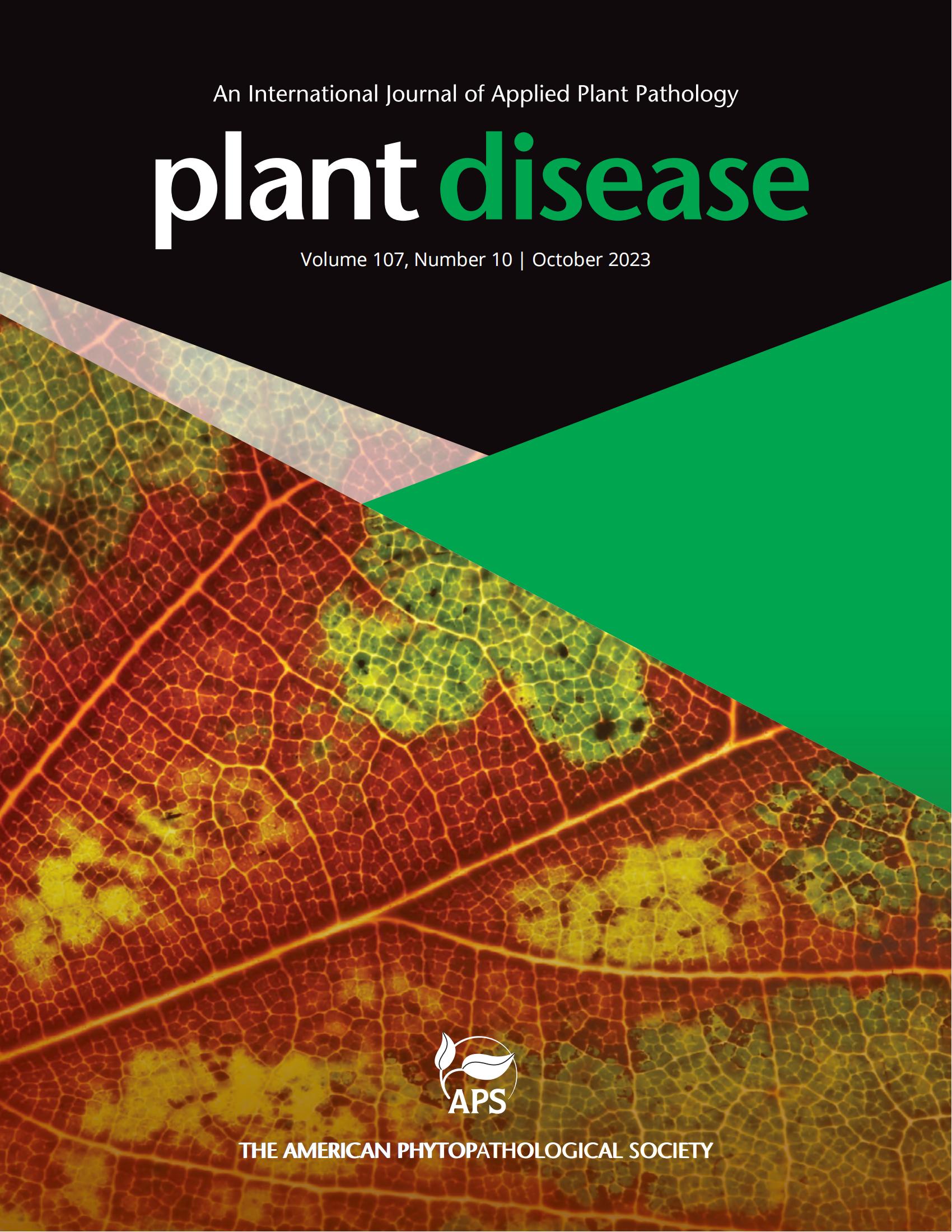中国首次报告巴西果胶杆菌导致甜瓜软腐病。
摘要
2024年5月,在浙江省宁波市(29.52°N, 121.31°E)发现甜瓜茎软腐病。两个温室(各约8 m × 50 m)的发病率约为30%。软腐黄褐色病变发展在受感染的茎,软腐与坏的恶臭。为鉴定病原菌,采用75%乙醇浸泡30 s,然后用无菌蒸馏水(SDW)冲洗3次的方法对4株植物的病茎进行表面灭菌。茎被切成5毫米的碎片,放置在SDW中。5分钟后,将100µL的水涂在营养琼脂(NA)上。28℃孵育24 h后,选择7个菌落,分别转移到新的NA板上。随机选取3株(PB052001、PB052002和PB052003)作为代表进行进一步研究。在NA上进行条纹接种,形成单菌落(28℃,3 d)。菌落形状为白色,圆形,边缘整齐,微凸起。使用easyypure细菌基因组DNA试剂盒(TransGen,北京)提取三株细菌的总基因组DNA。用它作为模板,用特异引物对16S rDNA及5个内保基因(pgi、proA、mtlD、mdh和icdA)进行PCR扩增(Lane 1991;Ma et al. 2007;Waleron et al. 2008)。得到的DNA片段被克隆并测序。这3株细菌在6个位点上的DNA序列100%相同,因此只有菌株PB052001的DNA序列被保存在GenBank中。序列分析显示,PB052001 (GenBank Acc No. 16S rDNA;PQ146559)与巴西乳杆菌SR10 (CP084655)和21PCA AGRO2 (CP113504)的同源性分别为99.67% (1501/1506 nt)和99.60% (1500/1506 nt)。基于PB052001 (GenBank Acc号分别为PQ145967、PQ145968、PQ145969、PQ145970和PQ145971)的pgi、proA、mtlD、mdh和icdA进行多位点系统发育分析。结果表明,这3个菌株与巴西孢子虫聚集在一起。为了确定致病性,将PB052001菌悬液(108 cfu/mL)注射到甜瓜(丰素10号)幼苗子叶下1cm处,每株10µL。10株幼苗注射SDW作为阴性对照。处理后的幼苗在28℃、80%相对湿度下生长。24 h后,在对照植株保持健康的情况下,接种该菌的植株出现了软腐病症状。另外,在甜瓜叶片上喷洒细菌悬浮液(每处理10个),并在甜瓜叶片上喷洒SDW作为对照。这些植物在上述相同条件下孵育。3 d后,对照叶片仍保持健康,处理后叶片出现软腐病症状。从病变组织中重新分离细菌,经形态学和分子鉴定,该细菌与PB052001相同。巴西疟原虫寄主范围广泛,尤其在葫芦科如黄瓜和西瓜中(Ma et al. 2007;Waleron et al. 2008)。据我们所知,这是中国首次报道巴西孢子虫引起甜瓜软腐病。这一发现扩大了我们对巴西疟原虫宿主范围的认识。这种病害对当地的甜瓜产业构成威胁。In May of 2024, a stem soft rot disease in melon (Cucumis melo L.) was observed in Ningbo (29.52°N, 121.31°E), Zhejiang Province of China. The disease incidence was approximately 30% in two greenhouses (ca. 8 m × 50 m each). The soft rot yellowish-brown lesions developed on infected stems, soft rotted with a bad foul odor. To identify the pathogen, the diseased stems from four plants were surface sterilized by soaking in 75 % ethanol for 30 s, followed by rinsing three times in sterile distilled water (SDW). The stems were cut in 5 mm fragments and let stand in SDW. After 5 minutes 100 µL of the water was spread on nutrient agar (NA). After incubation at 28°C for 24 h, seven bacterial colonies were selected and individually transferred to new NA plates. Three strains (PB052001, PB052002 and PB052003) were randomly selected as representatives for further study. They were streak-inoculated on NA for formation of single colonies (28°C, 3 d). The colonies were white and round in shape with neat, slightly raised margin. Total genomic DNA was extracted from the three bacterial strains using EasyPure Bacterial Genomic DNA Kit (TransGen, Beijing). It was used as template for PCR amplification of 16S rDNA as well as the five house-keeping genes (pgi, proA, mtlD, mdh and icdA) using specific primers (Lane 1991; Ma et al. 2007; Waleron et al. 2008). The resulting DNA fragments were cloned and sequenced. The three bacterial strains had 100% identical DNA sequences at each of the six loci, therefore, only the DNA sequences from strain PB052001 were deposited in GenBank. Sequence analysis showed that the 16S rDNA in PB052001 (GenBank Acc No. PQ146559) was 99.67% (1501/1506 nt) and 99.60% (1500/1506 nt) identical to those in Pectobacterium brasiliense SR10 (CP084655) and 21PCA AGRO2 (CP113504), respectively. A multilocus phylogenetic analysis was done based on pgi, proA, mtlD, mdh and icdA from PB052001 (GenBank Acc Nos. PQ145967, PQ145968, PQ145969, PQ145970 and PQ145971, respectively). The result showed that the three strains clustered together with P. brasiliense. To confirm pathogenicity, a bacterial suspension of PB052001 (108 cfu/mL) was injected into stems (10 per treatment) of melon seedlings (cultivar Fengsu No.10) at 1 cm below the cotyledons, 10 µL for each plant. Ten seedlings was injected SDW as negative control. The treated seedlings were grown at 28°C under 80% relative humidity. After 24 h, while the control plants remained healthy, the plants inoculated with the bacteria showed soft rot symptoms. Additionally, the bacterial suspension was sprayed on melon leaves (10 per treatment), and SDW was sprayed on melon leaves as a control. The plants were incubated under the same conditions described above. After 3 d, the control leaves remained healthy, the leaves treated with the bacteria exhibited soft-rot symptoms. Bacteria were re-isolated from the diseased tissues, and morphological and molecular identification showed that it was identical to PB052001. P. brasiliense has a broad host range, especially in Cucurbitaceae such as cucumber and watermelon (Ma et al. 2007; Waleron et al. 2008). To our knowledge, this is the first report of P. brasiliense causing soft rot disease on melon in China. The finding expands our knowledge about the host range of P. brasiliense. This disease poses a threat to the local melon industry.

 求助内容:
求助内容: 应助结果提醒方式:
应助结果提醒方式:


